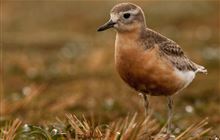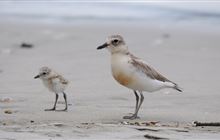Opoutere dotterels feel pressure of careless beachgoers
Archived content: This media release was accurate on the date of publication.
Introduction
Beachgoers ignoring clear signage and traipsing through a key nesting site in the Coromandel are putting vulnerable dotterels/tuturiwhatu and variable oystercatchers/torea-pango at risk.Date: 21 September 2022
Dotterel Ranger Frouk Miller says DOC has been informed many times that people have walked right past clear dotterel protection signs, before clambering through a rope put in place to mark the birds’ nesting site - and then strolling right through the restricted shoreline breeding ground.
“This area is roped off every year at this time to protect these birds and their nests,” Frouk Miller says.
“There’s plenty of signage at the site instructing people to stay out of the area – they only have to walk a few extra minutes to get to the beach if they follow our instructions.”
The rope and signage marking the dotterels’ Opoutere Spit nesting area were installed on 3 September, and barely a day later people were seen walking right through the nesting site. People walking through dotterel nesting sites may damage nests or cause the birds to abandon nests.
“Every season, I’ve witnessed it myself and had reports of people reading the signage, looking around to see if anyone’s watching, and then do exactly the opposite to what we’re asking – which is to just walk a little further and give the dotterels some space, peace and quiet.
We don’t enter the dotterels nesting areas ourselves, to having people traipsing right through is incredibly frustrating and hampering our ongoing efforts to protect them.”
Dotterel face a number of threats from introduced predators, dogs and other birds, so humans intruding on their nesting areas is adding the stress dotterels face during this important nesting and breeding time.
Human intrusion causes dotterel chicks to scatter across a beach, putting them at risk of being killed by other territorial birds. Chicks can also be kept from regular feeding at the tide line, and without adequate food they can die from starvation as they are not fed by their parents.
The interaction between people and dotterels occurs because the birds nest above the high-tide mark, where humans like to sunbathe, walk or leave their belongings while they swim.
DOC will continue to monitor the dotterels’ breeding sites around the Coromandel, and anyone found breeching the roped-off areas can face an $800 fine under the Wildlife Act.
Anyone who witnesses people intruding into a dotterel nesting site is urged to report it via 0800 DOC HOT,and include descriptions of those responsible and details of any vehicles they may have used.
The intrusions into the dotterel protection sites have been reported during Conservation Week, when DOC’s Coromandel and Hauraki districts put out a call for more people to become dotterel minders.
Background
The endangered New Zealand dotterel was once widespread and common, but is now classified as ‘Threatened – Nationally Critical’.
There are only about 2500 birds left, making dotterels more at risk than some species of kiwi.
New Zealand dotterel nest in open sites, typically low-lying sand or gravel banks and sandbars close to beaches and lagoons. Nests just above high tide mark are easily lost to strong storms and very high spring tides.
The birds often nest close to residential or developed areas. Their breeding habitats are at risk to development and subsequent erosion.
Contact
For media enquiries contact:
Email: media@doc.govt.nz


